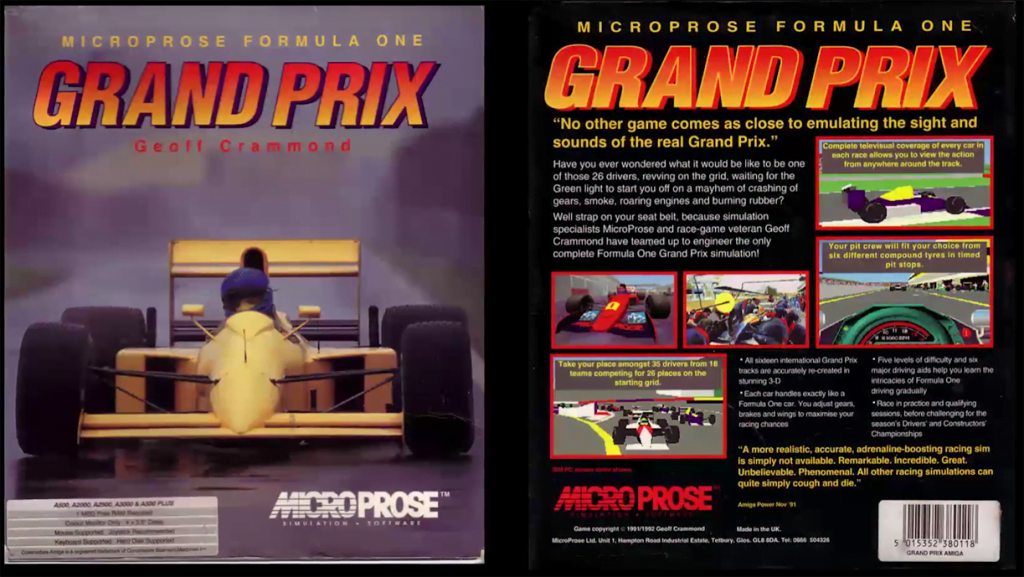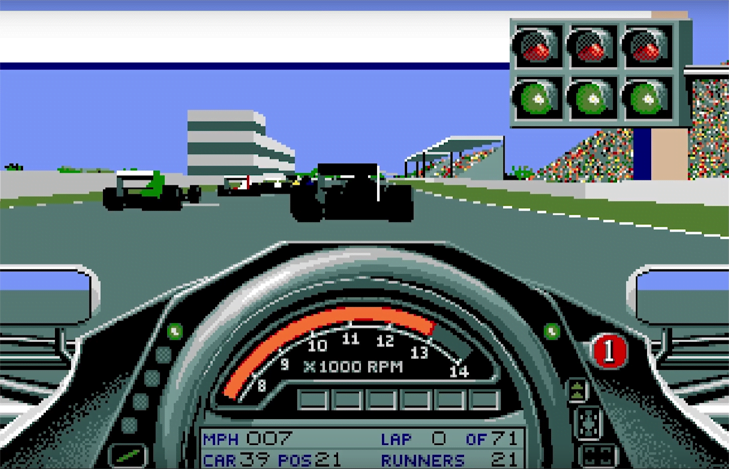This is a review of Geoff Crammond’s Formula One Grand Prix. Otherwise known as F1GP or World Circuit in America, it is the game that started the legendary Grand Prix series.
This is also the first video for the How to Retro YouTube channel that I have produced. So be sure to visit the How to Retro YouTube channel and subscribe so you are always notified of new video content from How to Retro.
Geoff Crammond – The Early Years
F1GP is the 7th game Geoff Crammond developed out of 12 that were published over a period of 21 years. His first 3 games released from 1981 to 1984 were exclusively on the BBC Micro.
These were Super Invaders, Aviator & Revs. Revs were the first indication that racing games with realistic mechanics were possible on home computers. A theme that would continue with the majority of his games from this point on.
Next from 1986 to 1989 came Revs Plus (only released on the C64), and then Sentinel and Stunt Car Racer followed. This also saw Geoff’s games progress away solely from the BBC Micro and onto more widely adopted home computers such as the ZX Spectrum, C64, Amstrad CPC, Amiga, Atari ST & PC.
F1GP – The Start of Sim Racing?
This brings us to F1GP, the first game in the legendary series. Published by Microprose and released in 1991 on the Amiga & Atari ST, and then in 1992 on the PC, the game received incredibly positive reviews.
F1GP did not officially hold the right to use the authentic driver and team names. It is based on the 1991 season though, utilising all the real-life car and helmet designs. Also most importantly, it had all 16 championship circuits all mapped out accurately in their true-to-life forms.
The game manual is vastly comprehensive at 165 pages. It covers everything from car control, car setup, and a quick reference guide to how to set up your car depending on its behaviour.
It even included track guides for all 16 tracks and insights for teams/drivers and Formula 1 as a whole. It’s one of the things that gamers from that generation miss these days!
The team and driver names are fairly inconspicuous with a couple being more obvious as to what they are intended to be. For example, the McPherson team can only be of course McLaren. The driver select screen does have real-life driver helmet designs.
You can also replace the fake driver names with real-life versions and save them so you can return to them later. Which is convenient and a nice touch at the time.

f1GP – the Game
The game offers driver aids which allow new players to ease themselves into the experience. It offers auto brakes, auto gears, self-righting spins, indestructible cars, show/hide the best racing line and also suggested gear help. These can be activated/disabled in the game with the F1-F6 keys. If you play F1GP on a higher difficulty level it will make some if not all aids unavailable.
Once you get to the track, you have car setup and tire choice options. Tire choices are easy, they range from A to D (Hard to Super Soft compounds), Q for qualifying tires and W for wet. The softer the compound, the quicker they wear down (relatively based on your driving).
The qualifying tires last a couple of laps before they start to degrade and the Wet tires are obviously meant for wet weather. If you accidentally put these on the car in the dry, they will not perform well and you’ll need to switch to a dry tire.
Car setup modifications allow you to modify wing angles, brake balance as well as gear ratios. If you run a full race distance, a good set-up and the right tyre choice are absolutely pivotal. Setting your car up with a lot of oversteer and driving aggressively would mean that your tires would ultimately suffer, meaning more pit stops.
But that is the genius behind the mechanics, you could plan a 3 stop race on softer tires, and drive aggressively, but then you may damage your car or get held up lapping other cars ruining your race strategy.
There is a fair amount of deep thinking that went into before and during each race. This is what made F1GP hugely satisfying.

Power Hungry!
The game itself looked good given the power available at the time, with the frame rates being the only bottleneck. This is more of a factor on the Amiga and Atari ST versions which run at 8 frames per second.
The PC version would run up to 25.6 frames per second making for a much smoother experience. You are able to switch between 3 detail settings, so running it at the minimum detail on the 68000 Amiga’s seemed to help deliver a more consistent frame rate.
The sound is reasonably solid too, engine noises in games at that point in time generally were quite whiny/tinny. The F1GP engine sample although initially sounding unnatural did really add to the feel and excitement with its gravelly but high-pitched tone. The track cams utilised sampled engine sounds for when cars speed past the camera.
F1GP had 4 main camera views, on board, behind, in front and trackside. Something certainly not common in games other than in flight simulators, but not that common for racing games. This made the game even more appealing to racing enthusiasts.
The ability to watch whole races from trackside cameras without even having to play the game is great. Fast forward 20 years or so, watching game streams, especially online racing for games such as iracing and rfactor is huge – Another pioneering feature from Geoff Crammond!
Undertaking a championship season is where the game really shines. The ability to run an extensive race weekend across all 16 of the tracks raced on in the 1991 season is an absolute thrill. I would recommend anybody give it a try, it is a test of skill and endurance. If you played the game properly, it certainly rewarded you in the satisfaction stakes when you eventually did overcome and win.
Bringing the Game up to Date
The problem with games based on real-life sporting seasons, they quickly become outdated. As the 1992 season got underway the year after its release. New driver lineups, new teams, car and helmet design changes are common when a new season arrives.
So for real enthusiasts, this meant a long wait for F1GP 2, or the ability to modify the game yourself. Unfortunately, both Grand Prix 2 and the ability to edit the game were not available quite so soon (and of course Grand Prix 2 never made it to the Amiga). But in February 1994, a program called F1Ed, developed by Steven Smith was released.
This allowed rudimentary editing of the F1GP binary file, allowing changes to the game. This was followed up later in the year by an editor called F1GP-Ed, which became the default choice for F1GP players.
Developed by Oliver Roberts and allows users to modify the game in lots of ways. This includes updating car, helmet and pit crew colours, cockpit templates, changing sound samples and the computer AI levels. The ability to increase frame rates to 20fps was added too, which requires at least an 020 processor to benefit.
This does not scratch the surface of what F1GP-Ed can do as a whole. I would recommend taking a look to see for yourself the amount of hard work that has been invested. You will find links to F1GP-Ed in the video description.
F1GP-Ed and the many other tools developed by the community gave the game an extended life far beyond what it would have achieved by itself. Geoff Crammond along with the enthusiastic and talented community of modders can take a lot of credit for setting the standard of where sim racing games needed to be from that point on.

The End?
F1GP, unfortunately, was the final game the Amiga would see from Geoff Crammond. Grand Prix 2 ended up being just too demanding for the ageing Amiga. The story of the Amiga and how any potential for it to evolve was destroyed in the latter years of Commodore’s life is well known, but as a series, the game went from strength to strength, technically speaking at least.
The later games in the series may have improved the mechanics, visuals, and gameplay. But none of the sequels made the same impact as the original game, which is, without a doubt, one of the best Amiga racing games ever made.
It is after all, hard to improve on perfection!
How to Play
If you want to play F1GP and other Amiga games, Amiga Forever is a great package that will get you up and running – https://www.amigaforever.com/
Also, check out Lemon Amiga. It has lots of interesting and useful links for all things Amiga. If you are searching for games to play, check out Lemon Amiga first – http://www.lemonamiga.com/
To modify F1GP, you can obtain a legitimate unlocked version of F1GP-Ed as well as many other F1GP tools – http://www.amigaf1.co.uk/

A lifelong avid gamer and computing enthusiast, Matt has decades of Retro Gaming experience. Now over 40 years old, Matt now even considers himself retro, but fortunately, nobody has developed a Matt emulator (not yet at least!).